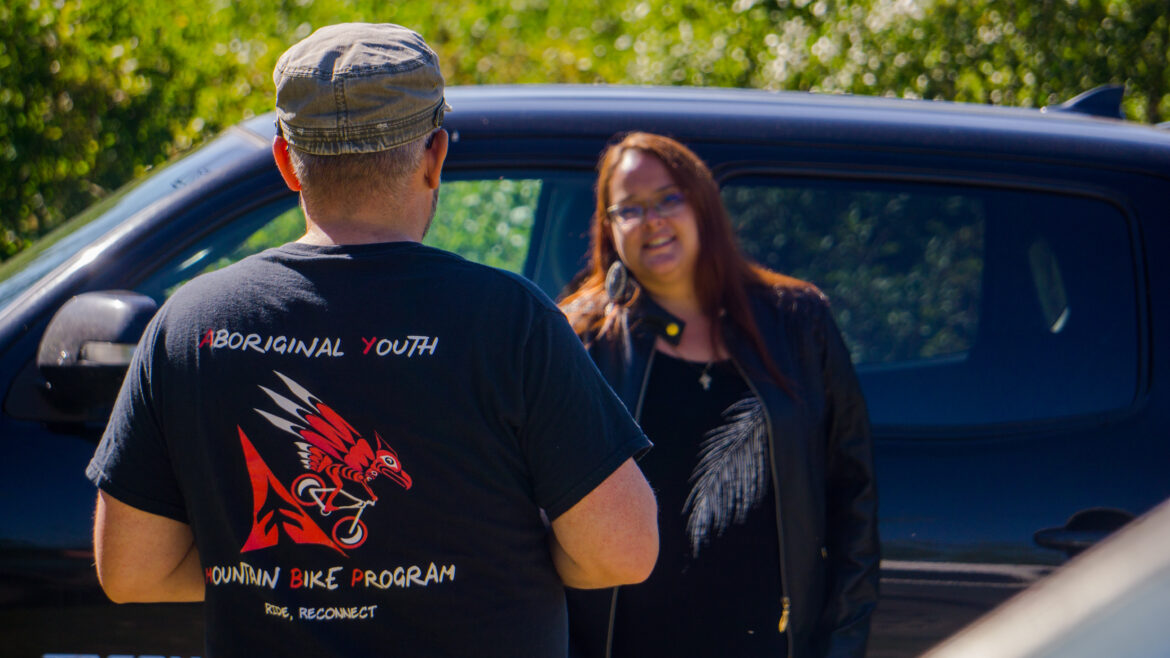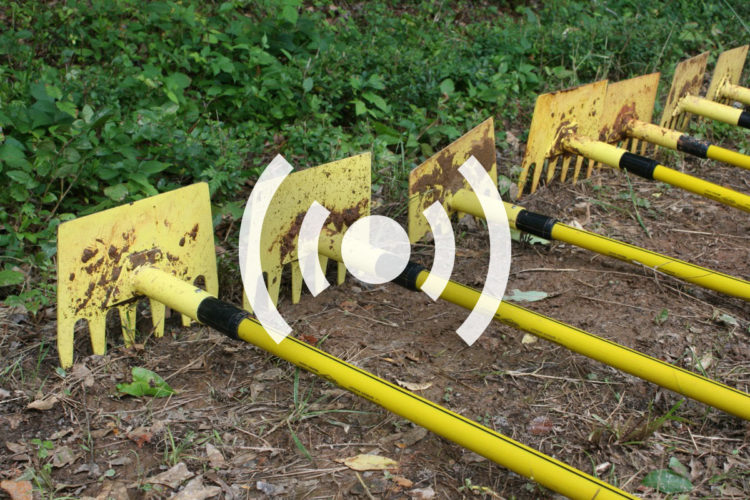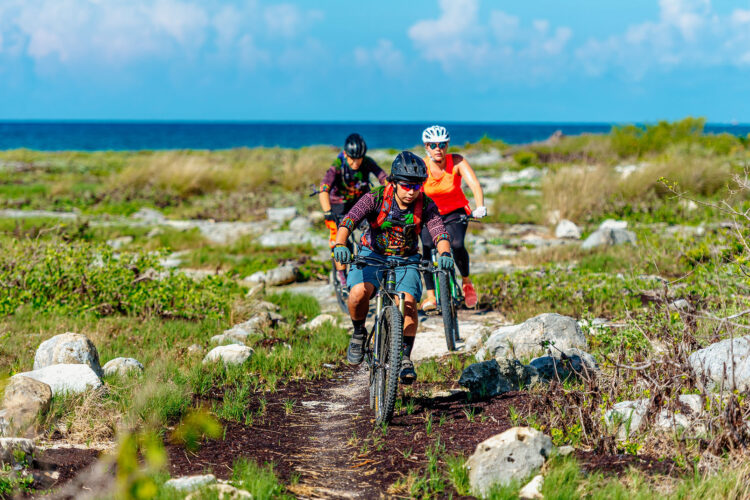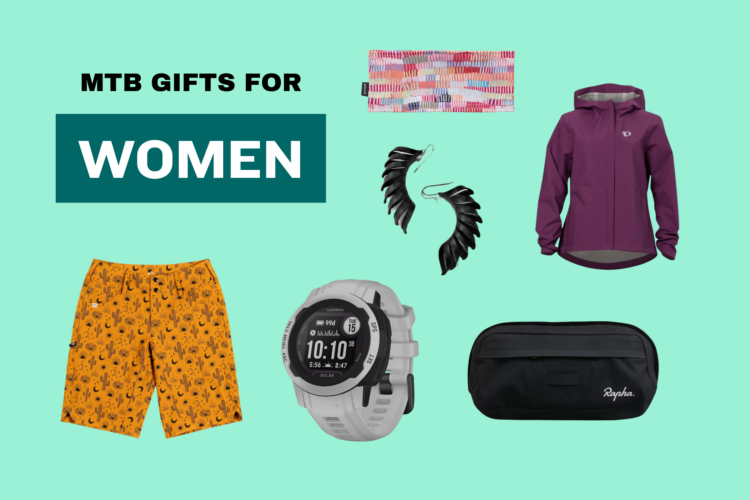
At first glance, in the stark contrast of bright sunlight on my back and deep shade ahead, I see a series of long, curved bones protruding up from the forest floor. Lined up one after the other, it’s the rib cage of a great beast that found its end overlooking Dragon Lake just outside the City of Quesnel in the Interior region of British Columbia.
“Trail fossil,” my friend and trail builder, Justin Darbyshire, commented as he walked up behind me. “They’re all over the place up here.”
“This would have been scary to ride,” Thomas Schoen, another friend and seasoned trail builder, observed.
Ian Van Luesden, the contracted Trail Coordinator for the City of Quesnel and the Cariboo Regional District, along with Alicia Evans of the Lhtako Dene First Nation on whose territory we were walking, were also standing nearby. We were in the forest to visit and view a newly completed mountain bike trail, Mucho Oro, when we stumbled upon the relic.
“What is it?” Alicia asked. As the Employment Coordinator for Lhtako Dene, she played a central role in bringing the trail project together. She was not, however, a rider.
“It’s a stunt,” I explained. “An old school North Shore feature.”
“People rode their bikes on that?” She whispered in awe. “That’s just crazy.”
It was indeed a fossil, the remnant of an earlier era of riding, an epoch when brave velo-pioneers scoured hillsides such as the one where we stood and struck the ultimate motherlode of loamy gold. They built and rode trails and stunts that pushed the sport beyond anything anyone had imagined and catapulted mountain biking into a global phenomenon.
“I rode this a few times,” Ian said. “Back when I first started riding. It was scary, but fun.” Ian was responsible for coordinating and overseeing a significant increase in the number of trails in and around the city. I had expected someone older, weathered, but he looked as though he had just graduated from college: young, fresh-faced with short brown hair, eager to ride the new trail.

The fresh ribbon of dirt was part of a broader collaborative initiative between the city, the regional district and the Lhtako Dene to build trails throughout the Nation’s traditional territories and support the economic transformation of the region. Together, they invested several years and hundreds of hours into developing their partnership. The Indigenous Youth Mountain Bike Program, a non-profit that works with Indigenous peoples throughout BC to build mountain bike trails, came on board to assist in completing the trail.
All across British Columbia, there are hundreds of abandoned ghost towns, the rotting detritus of settlements that sprung up around resource extraction projects only to eventually founder and disappear as the resources ran dry and they could not find new forms of sustenance. The City of Quesnel itself was in an increasingly precarious position. Over the previous decade, the community had lost two mills and more than 350 jobs. For Bob Simpson, the mayor, the choices were clear. “We could either preside over the death of our community, or we could lead the way and find a pathway to a more sustainable future.”
Many communities across Canada and North America are pinning their hopes on trails and mountain bike tourism as the next great economic savior. But what makes this industry any different from any other that involves utilizing and extracting value from the land? How can we be so sure it will lead the way out from the cycles of boom and bust to some measure of sustainable prosperity?
The name for the new trail, Mucho Oro, is Spanish for a “lot of gold.” It was named after a famous claim from the mid-1800s. It recalls a time when thousands of miners, including many Americans, flooded into the region, sparking violence and bloodshed as the Indigenous peoples fought back against the incursion. In an attempt to pre-empt American expansionism, the British declared the entire region, what would later become the province of British Columbia, as part of their colony. It was a historic land grab that assumed title to an area larger than most European Nations with absolutely no consultations with its current residents, and certainly not with the Indigenous peoples who had lived on the land and governed themselves for thousands of years.

Like so many other resource projects, the Mucho Oro claim eventually shut down leaving nothing behind but abandoned homes and rotting buildings.
This history underpins all our settler trails. It echoes a consistent pattern of extraction and the erasure of Indigenous people, culture, and claims to their lands and territories, whether for fur, gold, or epic rides. The Indigenous peoples have never forgotten and they have never given up the fight for their lands and territories.
When Ian accepted the position of trails coordinator with the City of Quesnel and the regional district, it was with the intent of finding a new way forward, of creating something that would last.
They selected some existing trails for renewal located on lands that belonged to the Lhtako Dene as part of a pilot project. It didn’t go as they hoped. The Lhtako Dene resisted, uneasy at the thought of allowing more people on their land. There was little trust and relatively little communication or connections between the communities. Over the next couple of years, the communities worked together, and undertook extensive listening sessions with elders, leaders, staff and community members. Eventually, they created a partnership agreement, along with the Gold Rush Cycling Club and the Cariboo Mountain Bike Consortium to guide trail development throughout the Lhtako Dene territories.
Alicia spoke highly of the results. “We created relationships,” she told me. “Staff to staff, need to need, rather than just top down from leadership. It created trust and communication. We could move things forward. It was more…” she paused, seeking the right word. “Symbiotic.”

The improved relations led to an ambitious effort to expand and build new trails around the City and the regional district throughout Lhtako Dene lands, including the Wonderland Trail network where Mucho Oro is located.
Mucho Oro was designed and built by Kelowna’s Andrew McIntosh as a 1,700m machine-built, downhill flow and jump trail with sweeping berms and a flowing track that cut down steep hill sides through the forest creating an experience that emulates the area’s history, recapture the adventurous frontier spirit.
In the dark forests of BC, the land can be difficult to navigate, a trickster that can transform from soft loamy dirt to endless fields of root-tangled rocks with the swing of an axe. As we would learn, building a successful trail cannot be done through brute force and technology alone.

Thomas Schoen, a seasoned builder with more than twenty years of experience working with Indigenous peoples, knew exactly what Mucho Oro needed. “Sometimes, you have to get off the machines, slow things down, get down in the dirt, and build with your hands.” Most importantly, Thomas believed the trail needed a softer touch, by people who knew and loved the land, who knew its stories and the history.
That was when Ian and Thomas decided to engage the Indigenous Youth Mountain Bike Program. Since 2008 we had successfully trained more than a dozen Indigenous trail crews across Northern BC that were responsible for building dozens of world class trails.
Four members of the Lhtako Dene were trained as builders. They immediately got to work, carving and shaping the trail, applying the finishing touches.
As they worked side by side, making their way up the hill, laughing and sharing stories and jokes, the forest seemed to relent, giving itself up, revealing its secrets, the trail forming behind them into a beautiful curved dirt and loam path that swept down the slope.
“It was the most fun I’ve ever had working with a crew,” Justin later told me. “We laughed all day long.”

“Everything depends on relationships,” Alicia was always reminding us. “How you approach the land is everything.”
Within a week the trail was fully completed and ready to ride.
After completing the site inspection with Alicia, the remainder of us returned with our bikes. Mucho Oro was everything you could hope for in a trail: fast, flowy, and playful. We rode down the trail, one after the other, pumping into wooden berms and launching ourselves down the slope, the old rotting features in the adjacent forest clattered their approval as we went flying past.
The trails continue to grow and the city continues to hire the Lhtako crew. The trails are viewed and understood as a shared resource, something that must be tended to and cared for, a symbiotic relationship. Ian and Alicia have big plans including a full time professional Lhtako crew responsible for building and maintaining the trails.
Communities across North America and around the world are facing multiple crises: climate change and environmental collapse, pandemics and social upheaval. We must find ways to adapt and change, to reckon with and address our histories and present realities. This means engaging with the Indigenous people who have lived on the lands where we ride and play since time immemorial and strive to build relationships based on trust and respect. It means rethinking how we build trails and who we are building them for. It can be scary and challenging, like riding a narrow skinny high up in the trees and hucking ourselves off a massive drop. Quesnel and the Lhtako Dene have shown us how to stick the landing. If we don’t, all that will remain of our sport and the trails we love, will be piles of forgotten trail fossils rotting in the woods.
To learn more about the trails in Quesnel, visit TourismQuesnel.com











1 Comments
Nov 22, 2020